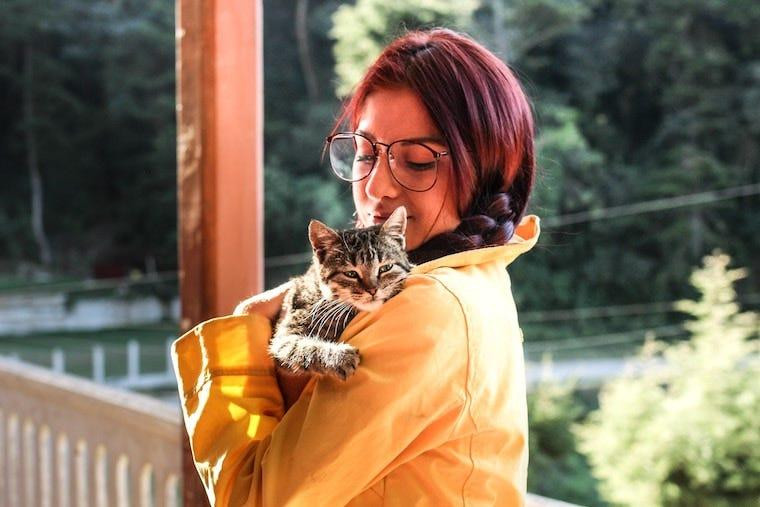Have you ever seen a cat sporting a pair of glasses and wondered why? It’s undeniably adorable, and images of cats in spectacles have become increasingly popular online. One might assume these feline frames are for vision correction, similar to humans. However, the reality behind Cats And Glasses is a bit more nuanced and fascinating, delving into the intriguing world of cat vision.
Truffles: The Kitty Inspiring Kids with Glasses
One cat who has truly embraced eyewear is Truffles, a charming tuxedo cat who has captured hearts globally. This special kitty works at A Child’s Eyes, a children’s optical shop, where she plays a vital role in helping young patients feel comfortable with their own glasses. Truffles became an internet sensation when the optical shop shared photos of her wearing various stylish eyeglasses.
 caucasian woman with eyeglasses wearing a yellow coat holding a tabby cat
caucasian woman with eyeglasses wearing a yellow coat holding a tabby cat
Truffles serves as an “honorary eyeglass instructor,” demonstrating to children how fun and normal it is to wear glasses and even eye patches. She assists in teaching them about eye tests and recognizing shapes, making the experience less daunting and even enjoyable. Truffles’ work highlights a heartwarming and unique reason for cats and glasses to be associated – not for the cat’s vision, but for the emotional support they provide.
Understanding Cat Vision vs. Human Vision
While Truffles wears glasses for inspirational purposes, it’s important to understand that cats rarely need glasses for vision correction in the same way humans do. This is because cats’ vision is fundamentally different from our own. Humans typically aim for 20/20 vision, but a cat’s visual acuity is generally around 20/100 or 20/200.
According to Dr. DJ Haeussler, a veterinary ophthalmologist, this means, “a cat would have to be 20 feet from an object to see it as sharply as a human would from 100 feet away.” However, this doesn’t mean cats have “bad” vision; it’s simply adapted for their predatory lifestyle.
Cats excel in low-light conditions due to a higher concentration of rods, the photoreceptors responsible for night vision. Experts estimate that cats can see six to eight times better in the dark than humans.
Here are some key differences in cat vision compared to human vision:
- Limited Close-Up Vision: Cats lack the necessary eye muscles to significantly alter their lens shape, hindering their ability to focus on close objects.
- Color Perception: Cats have fewer cones, the photoreceptors for color vision, resulting in a less vibrant and narrower color spectrum compared to humans.
- Superior Motion Detection: Cats are exceptionally good at detecting fast movements, a crucial skill for hunting.
Cat Eyesight Compared to Dog Eyesight
 brown and white tabby cat looking at a black and white dog
brown and white tabby cat looking at a black and white dog
When comparing cat vision to dog vision, there are also notable differences. While dogs possess wider peripheral vision, cats have superior binocular vision. This enhanced binocular vision allows cats to judge distances more accurately, which is essential for hunting small prey like mice and birds.
Interestingly, both cats and dogs share a unique visual trait: the ability to see some ultraviolet (UV) light. Their lenses allow a certain amount of UV light to pass through, contributing to their excellent vision in low-light environments.
Recognizing Vision Loss in Cats
Just like humans and dogs, cats are susceptible to vision loss and even blindness. Various factors can contribute to feline vision problems. According to PetMD, common causes of vision loss in cats include diseases, injuries, and age-related degeneration.
Signs of Potential Vision Problems in Cats
It’s crucial for cat owners to be vigilant about their feline companions’ eye health. Regular veterinary check-ups, at least annually (and bi-annually for cats over 10), are vital for early detection of any vision-related issues. Early diagnosis significantly improves the chances of managing or slowing down vision loss.
Be aware of these symptoms that may indicate vision loss in your cat:
- Cloudy, discolored, or inflamed eyes
- Dilated pupils that remain large even in bright light
- Increased startle response
- Disorientation or confusion when furniture is moved
- Bumping into objects
- Misjudging jumps and heights
Vision is undoubtedly important, but vision loss isn’t insurmountable for cats. They are remarkably adaptable creatures. If your cat is experiencing vision decline, remember that they can still live full and happy lives. You can also explore resources about adopting a blind cat to understand how well these animals can adjust.
While cats and glasses might often be seen together in amusing online content, the real story is more about adorable inspiration and understanding the fascinating nuances of feline vision.
Sources:
Cover photo by Tengy Art on Unsplash
[

